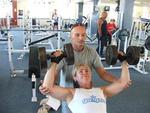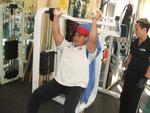Cardiovascular Fitness Programs
Types of Cardio Training
Continuous training
Continuous training involves activities where most energy is supplied by the aerobic system. This is the type of training you would have been doing in Phase 1 (eg, going for a 30-60min walk/run). At this stage you should be able to sustain at least 20-90 minutes of activity. Your training intensity should be 65%-80%Hrmax.
Fartlek training
This form of training involves interspersing short bursts of intense/faster work throughout a continuous activity. It is a great way of introducing more intensive work. The difference between this activity and pure continuous work is that there is a deliberate attempt to increase the intensity which causes a temporary build-up of lactic acid.
For example:
- You are completing a 20 minute run. Increase your running speed (sprint) until your heart rate reaches 90%HRmax, then slow down to a jog until it reaches 65%HRmax. Repeat this throughout the run. *These HR zones are only used for this example and can be adjusted to suit each individual.
Interval training
This form of training involves alternating periods of activity and recovery. The advantage of this form of training is that it provides greater amounts of exposure to intensive training without incurring excessive fatigue. Greater recovery will occur if you remain walking or moving throughout. This increases the body's ability to remove lactic acid from the muscles, take it back to the liver, and convert it to energy.
A good way to improve your fitness is to work on a 1:1 or 1:2 work to rest ratio.
For example:
- You are completing a 20 minute training session. After warming up, run hard for 2 minutes then walk for 2 minutes. Complete this 4 times.
or
- You are completing a 20 minute walk. Power walk to the first power pole, then walk slowly to the third, and so on.
You can decrease the rest time or increase the activity during the recovery period, as your fitness improves.
So how often should I be cardio training?
You would have already built a base so regular exercise is no concern for you. The problem can be the increase in intensity with the Fartlek and Interval training. Start by incorporating 1-2 sessions per week of high intensity and 1-2 sessions per week of Continuous training. Extra sessions can be added as you adapt but also include rest days. These will allow your body to recover and improve. They will also reduce the chance of over-training or overuse injuries (eg, plantar fasciitis, shin splints, etc).
Interval Training
Lactic Acid Tolerance and Clearance
Methods of Lactic Acid Tolerance
To get the best out of our training we need to be able to tolerate high levels of lactic acid. This will enable us to perform at higher intensities and sustain it for longer periods.
- Duration of work: 30sec to 2min
- Intensity of work: 90-95% of best time for distance
- Recovery period: 1.5-6min
- Work-recovery ratio: 1:2 to 1:3
- Repetitions: 3-12
Methods of Lactic Acid Clearance
Clearance is important because it improves the body's ability to remove the lactic acid from the muscle, transport it via the blood stream to the liver, then convert it back to energy.
- Duration of work: 5-30sec
- Intensity of work: 95+ % of best performance
- Recovery period: 15-150sec
- Work-recovery ratio: 1:3 to 1:5
- Repetitions: 5-20
Sample Cardio Fitness Programs
*Always consult your Doctor before starting an exercise program!
Program 1
- Warm up and stretch for 5-10 minutes.
- Jog for 100m, walk for 200m.
- Repeat 5 times.
- Always complete a warm down before finishing the session.
Program 2
- Choose a piece of cardiovascular equipment (eg, Bike, Rower, etc.)
- Warm up and stretch for 5-10 minutes.
- Complete 2 minutes at 85%, then 2 minutes at 60%.
- Repeat 4 times.
- Increase the high intensity section and keep the low intensity section the same as it becomes easier.
- Always complete a warm down before finishing the session.
Program 3
- Warm up and stretch for 5-10 minutes.
- Complete the following intervals 4 times: 1 minute at 90%, 2 minutes at 60%.
- Increase the high intensity section and keep the low intensity section the same as it becomes easier.
- Always complete a warm down before finishing the session.
Program 4
Indoor Cardio Circuit:
- Warm up and stretch for 5-10 minutes.
- Choose 3 pieces of Cardio equipment (eg, Bike, Treadmill, Rower).
- Complete 2 circuits of the machines spending 5 minutes on each machine, each time. (eg. 5min on bike, then treadmill, then rower, at the first intensity. Then go through again at the second intensity).
- Spend first circuit at 60%-70% HRmax.
- Spend second circuit at 70%-80% HRmax.
- Always complete a warm down before finishing the session.
Cardio Programs For the Fit Only
Program 1
- Warm up and stretch for 5-10 minutes.
- Complete the following intervals 5 times: 4 minute at 90%, 2 minutes at 60%.
- Always complete a warm down before finishing the session.
Program 2
Indoor Cardio Circuit:
- Warm up and stretch for 5-10 minutes.
- Choose 3-4 pieces of Cardio equipment (eg, Stepper, Bike, Treadmill, Rower).
- Complete 3 circuits of the machines spending 5 minutes on each machine, each time (eg. 5min on bike, then stepper, then treadmill, then rower, at the first intensity. Then go through again at the next intensity, and so on).
- Spend first circuit at 60%-70% HRmax.
- Spend second circuit at 70%-80% HRmax.
- Spend third circuit at 80%-90% HRmax.
- Always complete a warm down before finishing the session.
Program 3
- Warm up and stretch for 5-10 minutes.
- Complete the following intervals 5 times: 400m at 90%, 400m at 60%.
- Always complete a warm down before finishing the session.
Program 4
- Warm up and stretch for 5-10 minutes.
- Complete the following intervals 5 times: 2min at 85%, 2min at 75%.
- Walk for 10 minutes.
- Complete intervals again.
- Always complete a warm down before finishing the session.
Program 5
- Warm up and stretch for 5-10 minutes.
- Complete the following intervals 5 times: Sprint 400m then jog until heart rate reaches 70% HRmax.
- After the 5 intervals, walk for 5 minutes.
- Repeat intervals.
- Always complete a warm down before finishing the session.






